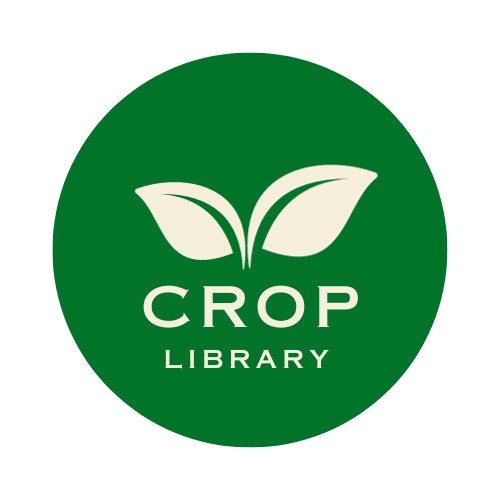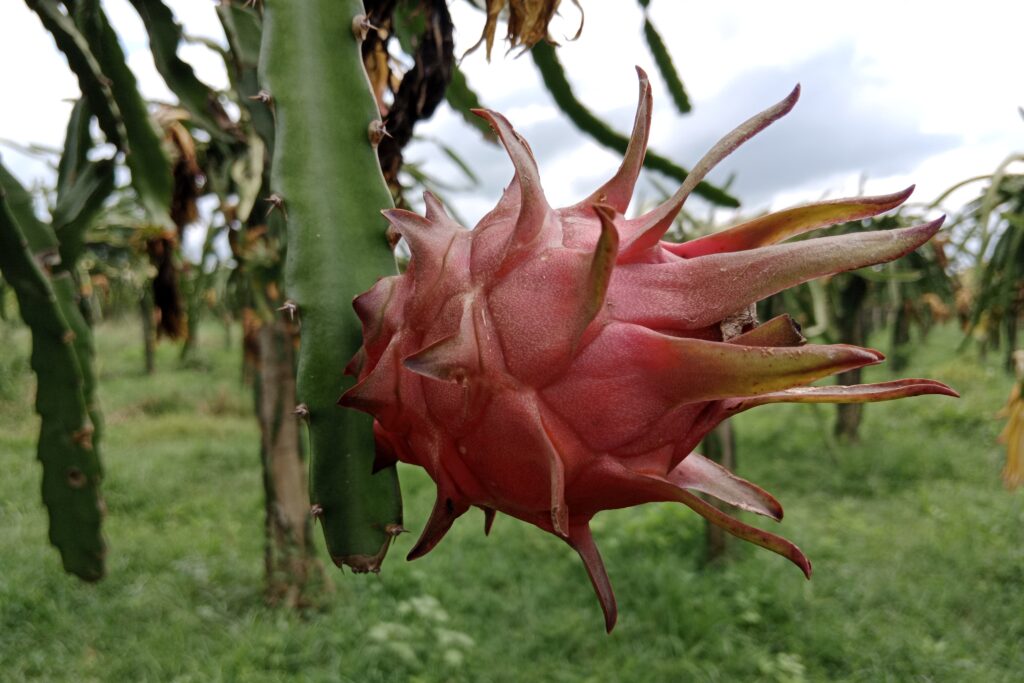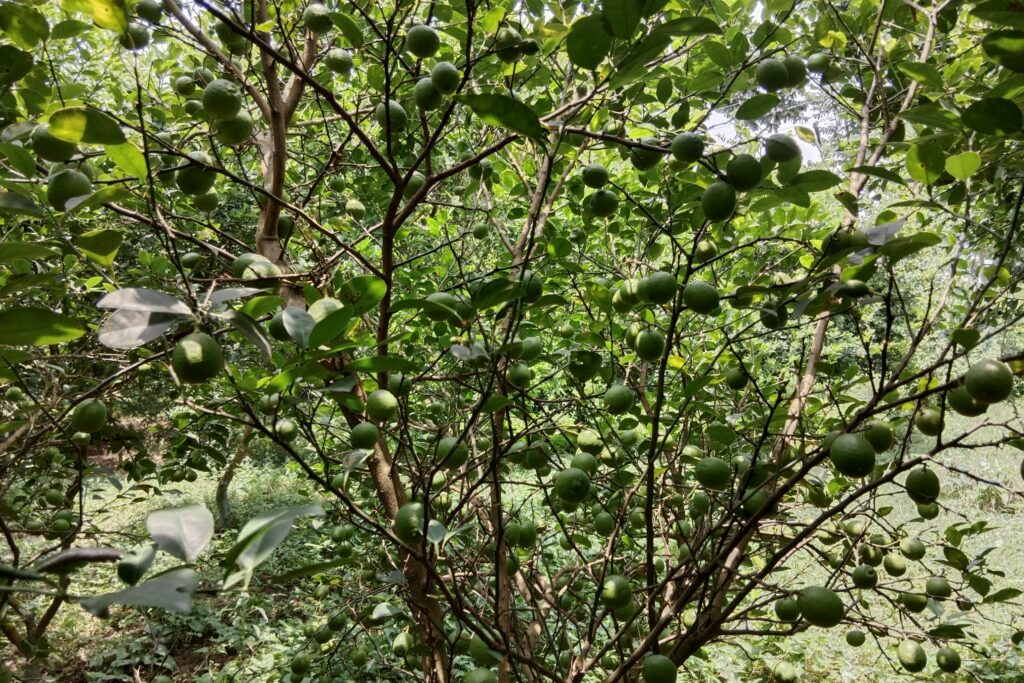Pear Farming
When analyzing pear farming profit per acre, low-density planting (168 trees/acre) requires an initial NRs 348,000 investment with NRs 150,000 annual maintenance, generating no income for the first 4 years before turning profitable in Year 6 (+NRs 150,000) and peaking at NRs 1.8 million annually (Years 11-20), totaling NRs 16.65 million over 20 years—ideal for traditional farmers seeking stable returns.
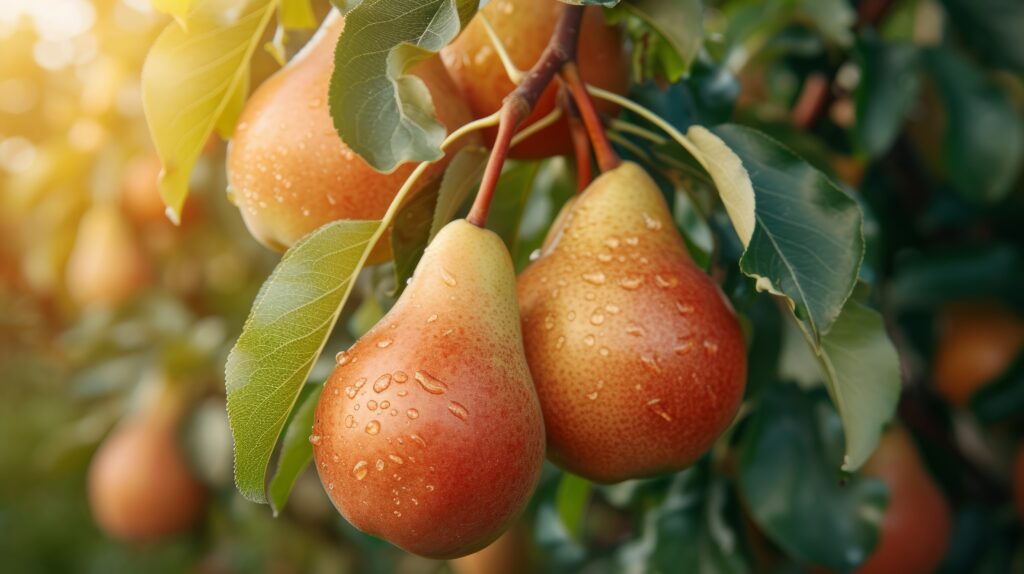
In contrast, high-density planting (674 trees/acre), while costing NRs 782,200 upfront with NRs 200,000/year maintenance, delivers faster pear farming profit per acre, yielding income by Year 4 (+NRs 100,000) and peaking at NRs 2.05 million annually (Years 11-20) for a 20-year total of NRs 20.22 million, though it requires intensive management and suits commercial growers prioritizing rapid ROI.
Both systems show strong pear farming profit per acre potential, with the choice depending on capital, risk appetite, and long-term goals. Below is a detailed breakdown of pear farming based on the given parameters:
Land Preparation
For effective pear orchard establishment, proper land preparation is essential: begin by clearing the land of weeds, rocks, and debris, then deeply plow the field (approximately 30-45 cm) to loosen the soil and improve aeration, followed by leveling to ensure uniform water distribution, and finally incorporate organic matter such as compost or well-rotted manure to significantly enhance soil fertility and create optimal growing conditions for pear trees.
Soil Type
Pear trees thrive in well-drained, loamy soils rich in organic matter, with an ideal pH range of 6.0 to 7.5 for optimal growth. Avoid heavy clay soils, which hinder proper drainage, and sandy soils, as they struggle to retain sufficient moisture and nutrients for healthy pear cultivation.
Climatic Requirements
Pear trees need 600–1000 chilling hours below 7°C for the best flowering, and they do best in temperate areas with cool winters (10–25°C) and moderate summers. They thrive when planted in temperatures between 10 and 18°C, and they prefer 800-1200 mm of yearly rainfall, while additional irrigation (50 to 75 mm) is necessary in dry areas. Young fruits and blossoms, however, are vulnerable to frost and frequently require safeguards to avoid harm.
Major Cultivars
Pear cultivation features several major cultivars, including Asian pears like the crisp and sweet Nijisseiki (20th Century) and early-maturing Shinseiki, European pears such as the soft and sweet Bartlett (Williams) for fresh eating and firm D’Anjou ideal for storage, along with hybrid varieties like heat-tolerant Le Conte that thrives in subtropical climates.
Planting

a). Planting Season
The optimal planting season for pear trees is late winter (February) or early spring (March) when the trees are dormant, while in subtropical regions, they can alternatively be planted during the monsoon season (June-July) to take advantage of the increased soil moisture and favorable growing conditions.
b). Spacing
For optimal pear orchard management, standard spacing requires 6 meters between rows and 4 meters between plants to allow proper growth and airflow, while high-density planting systems designed for dwarf varieties utilize a tighter 3m × 2m spacing to maximize yield per acre while maintaining plant health and accessibility for maintenance.
c). Pit Preparation
For proper pear tree establishment, prepare planting pits measuring 1m × 1m × 1m (length × width × depth), thoroughly mixing the excavated topsoil with 10 kg of well-rotted manure and 500g of Single Super Phosphate (SSP) to create a nutrient-rich growing medium before backfilling the pits, ensuring optimal root development and early growth conditions for the young saplings.
d). Planting Method
When planting pear saplings, carefully position each young plant in the center of the prepared pit, making sure the graft union remains 5-7 cm above the soil surface to prevent rootstock sprouting and promote proper growth, then thoroughly water the newly planted sapling to settle the soil around the roots and provide essential moisture for establishment.
e). Number of Plants per Acre
Pear orchard density varies significantly based on planting systems, with standard spacing accommodating approximately 168 plants per acre (6m×4m layout), while high-density cultivation can support up to 674 plants per acre (3m×2m spacing for dwarf varieties), allowing growers to choose between traditional orchard management or intensive production models based on their resources and market demands.
Intercropping
During the initial 3-4 years of pear orchard establishment, suitable intercrops such as legumes (beans, peas), vegetables (cabbage, spinach), and short-duration fruits (strawberries) can be cultivated to optimize land use, while heavy-rooted crops that compete for nutrients should be avoided; specifically, in kharif season, crops like mash, moong, and toria make excellent intercrops, whereas rabi season favors wheat, pea, and gram as ideal intercrops during the orchard’s non-bearing period.
Irrigation
Young plants require frequent light irrigation every 5-7 days to establish strong roots, while mature trees need deep irrigation every 10-15 days, adjusted based on soil moisture levels. Critical growth stages, such as flowering and fruit setting, demand adequate moisture to ensure proper development, and fruit development requires consistent watering to prevent water stress. For optimal water efficiency, drip irrigation is highly recommended in pear orchards as it delivers targeted moisture, conserves water and promotes healthy tree growth.
| Growth Stage | Frequency | Water Volume | Key Notes |
| Planting to 3 Months | Every 5–7 days | Light watering (keep soil moist) | Avoid waterlogging |
| 3–12 Months (Young Trees) | Every 10–12 days | 15–20 L/plant | Deep watering for root growth |
| Years 2–4 (Vegetative Growth) | Every 10–15 days | 30–50 L/plant | Increase in summer |
| Years 5+ (Mature Trees) | Every 15–20 days | 50–80 L/plant | Critical during flowering & fruiting |
Fertilizer and Manure
Proper fertilization is essential for healthy growth, high yields, and quality fruit production in pear orchards. Below is a stage-wise fertilizer guide covering the entire lifespan of pear trees.
a). Pre-Planting (Soil Preparation)
Pre-Planting (Soil Preparation): Two to three weeks before planting, enrich each pit with 10-15 kg of well-rotted FYM (Farm Yard Manure) or compost, along with mineral fertilizers including 500 g of Single Super Phosphate (SSP), 100 g of Trichoderma viridae, and 50 g of biofertilizer (containing nitrogen-fixing bacteria, PSB, and Potassium Mobilizing Bacteria). Additionally, adjust soil pH to 6.0-7.5 using lime for acidic soils or gypsum for alkaline soils to create optimal growing conditions for pear saplings.
b). Planting Stage (0-1 Year)
For the first three months after planting, avoid chemical fertilizers and only provide light watering to prevent root burning. After this initial period, fertilization begins with 50g of Nitrogen (N) per tree (using urea or CAN), 30g of Phosphorus (P) as SSP, and 30g of Potassium (K) as MOP, dividing these nutrients into two equal doses applied every three months to support healthy young tree development.
c). Young Trees (1-4 Years – Vegetative Growth)
| Year | N (g/tree) | P (g/tree) | K (g/tree) | Frequency |
| Year 1 | 50 – 70 | 30 – 50 | 30 – 50 | Apply equally in 3 split doses (March, July, October) |
| Year 2 | 80 – 100 | 50 – 70 | 50- 70 | Apply equally in 3 split doses (March, July, October) |
| Year 3 | 120 -150 | 70-100 | 70-100 | Apply equally in 3 split doses (March, July, October) |
| Year 4 | 150-200 | 100-120 | 100-120 | Apply equally in 3 split doses (March, July, October) |
d). Mature Trees (5+ Years – Fruiting Stage)
| Nutrient | Dosage (g/tree/year) | Application Time |
| Nitrogen (N) | 500-800 | 50% at flowering, 50% after fruit set |
| Phosphorus (P) | 200-400 | Full dose before flowering |
| Potassium (K) | 500-800 | 50% at fruit set, 50% before harvest |
| Micronutrients | Zn, B, Fe (as needed) | Foliar spray during growth stages |
Weed Control
Weed Control in Pear Orchards: Effective weed management can be achieved through mulching with organic materials like straw or black plastic to suppress weed growth, while mechanical methods such as hoeing are particularly useful in young orchards. If chemical control is necessary, herbicides like glyphosate can be applied with caution to avoid direct contact with the trees, ensuring targeted and safe usage.
Pest and Disease Management
Major Pests
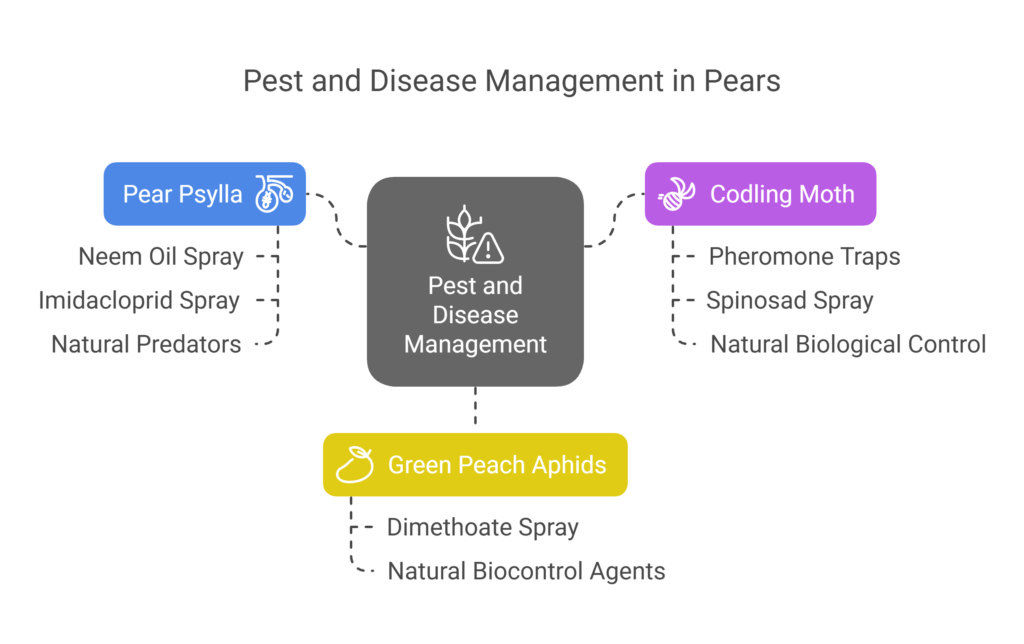
a). Pear Psylla
Nymphs and adults primarily feed on tender foliage and new shoots, extracting sap and excreting copious amounts of honeydew that coats trees, promoting sooty mold growth and rendering fruit unmarketable due to dark russet blotches. Fortunately,
Management
- Spray neem oil @ 5ml / litre water.
- Spray imidacloprid @ 1 ml / litre water.
- Natural predators such as lacewings, ladybird beetles, minute pirate bugs, predatory mites, anthocorid bugs, and spiders help control pear psylla populations, providing effective biological management of this pest.
b). Codling Moth
As a direct pest, the codling moth causes severe damage to pear fruits, with neonate larvae entering through the calyx to feed on seeds, resulting in deformed fruits that often drop prematurely. This infestation renders 30-70% of pear fruits unmarketable.
Management
- Use pheromone traps @ 5 traps / acre.
- Spray Spinosad @ 0.5 ml / litre water.
- Natural biological control agents help manage populations, including parasitoids like Trichogramma embryophagumand cacoeciae pallidum, as well as predatory birds such as the grey tit (Parus major) and house sparrow (Passer domesticus).
c). Green Peach Aphids
Green peach aphids reach high densities on young plant tissue, causing water stress, wilting, and stunted growth, with prolonged infestations significantly reducing yields in root and foliage crops—early-season attacks on potatoes are especially damaging even if aphids are later removed. Their presence also contaminates harvestable produce through direct infestation or sticky honeydew, often leaving yellow feeding blemishes on plant tissue. Fortunately,
Management
- Spray dimethoate @ 1ml / litre water.
- Natural biocontrol agents help manage populations, including the parasitoid Aphelinus and predators such as syrphid flies, lygaeid bugs, coccinellids (lady beetles), and lacewings.
Major Diseases
a). Canker
The disease manifests through bark wounds that develop into canker lesions, with initial leaf symptoms appearing in spring as small purple specks on emerging leaves that expand into circular 3-6 mm diameter lesions featuring purple margins and tan-brown centers. These leaf spots undergo secondary enlargement, causing severe chlorosis and defoliation. Infected fruits display distinctive concentric black-brown bands while maintaining firm, leathery flesh, often showing black pycnidia on their surfaces.
The pathogen persists as ascospores in soil debris, causing primary infections, while summer releases of conidia and ascospores from pycnidia and perithecia drive secondary spread. Disease development thrives at 20-24°C under moist conditions, with winter-injured plants being particularly vulnerable to infection.
Management
- Prune infected branche
- Spray the solution of streptomycin sulphate 0.5 g / liter water and copper sulphate @ 3g/ litre water.
b). Pear Scab
The disease primarily affects leaves and fruits, causing twisted or puckered leaves with black circular spots on the upper surface and velvety coalescing spots underneath, often leading to yellowing and premature leaf drop. It also infects flower stems, causing blossom drop, while fruit lesions become sunken and brown with spore margins, resulting in distorted, cracked fruits vulnerable to secondary infections.
The fungus overwinters in infected fallen leaves and fruits, occasionally on tree shoots, releasing airborne spores during spring bud burst that infect young leaves and fruitlets. These primary infections then produce wind- or rain-splashed spores that spread secondary infections. The disease thrives in wet conditions, making it particularly severe in humid regions with frequent rainfall.
Management
- Use copper-based fungicides (Bordeaux mixture) to manage the disease.
c). Powdery Mildew
The disease appears as buds develop into new leaves and shoots, presenting as white or grey powdery patches on leaf undersurfaces, causing leaves to grow abnormally narrow with curled margins while twigs become coated in powdery fungal growth. Infected fruits remain stunted, deformed, and develop rough surfaces. The pathogen persists through dormant mycelium or haustoria in buds, with secondary spread occurring via windborne conidia. Infections thrive when relative humidity exceeds 70% and temperatures range between 10-25°C, creating ideal conditions for disease development.
Management
Spray wettable sulfur @ 2g / liter water.
Harvesting
Asian pears typically mature 90-120 days after flowering, while European varieties require 120-180 days and should be harvested firm to ripen off-tree. Key indicators of maturity include a color shift from green to yellowish, slight softening near the stem, and easy separation from the spur. Yield varies significantly with tree age, with young trees (3-5 years) producing 10-20 kg per tree and mature trees (8+ years) yielding 50-100 kg per tree, reflecting the orchard’s productive capacity at different growth stages.
Initial Investment for Pear Farming Per Acre
Initial Investment Cost (Per Acre)
| S.N. | Categories | Low Density (NRs) | High Density (NRs) | Difference |
| 1 | Land Preparation (Plowing, Leveling, Pit Digging) | 40,000 | 50,000 | +10,000 |
| 2 | Pear Saplings | 50,000 | 202,200 | +152,200 |
| 3 | Fertilizers & Manure | 68,000 | 150,000 | +82,000 |
| 4 | Drip Irrigation Setup | 100,000 | 200,000 | +100,000 |
| 5 | Labor (Planting & Maintenance) | 30,000 | 60,000 | +30,000 |
| 6 | Pest & Disease Control | 30,000 | 50,000 | +20,000 |
| 7 | Miscellaneous (Equipment, Mulch, etc.) | 30,000 | 70,000 | +40,000 |
| Total Initial Investment | 348,000 | 782,200 | +434,200 |
Annual Maintenance cost for Pear Farming per Acre
The annual maintenance cost for pear farming per acre typically ranges between NRs. 150,000 to 250,000 from the second year onwards, with both low-density and high-density planting systems falling within this range, though high-density orchards often incur costs at the upper end of this spectrum due to their more intensive management requirements for optimal production.
Income from One Acre Pear Farming
| Year | Low-Density Yield (kg) | High-Density Yield (kg) | Market Price (NRs/kg) | Low-Density Income (NRs) | High-Density Income (NRs) |
| 3rd Year | 0 | 1,000 | 100 | 0 | 100,000 |
| 4th Year | 0 | 3,000 | 100 | 0 | 300,000 |
| 5th Year | 1,000 | 7,000 | 100 | 100,000 | 700,000 |
| 6th Year | 3,000 | 11,000 | 100 | 300,000 | 1,100,000 |
| 7th Year | 6,000 | 13,000 | 100 | 600,000 | 1,300,000 |
| 8-10 Year | 10,000 | 16,000 | 100 | 1,000,000 | 1,600,000 |
| 10-20 Year | 13,000 | 15,000 | 150 | 1,950,000 | 2,250,000 |
| 21+ Year | 10,000 | 0 (Replanting Needed) | 150 | 1,500,000 | 0 |
Analysis of Pear Farming Profit Per Acre
Low-density planting (168 trees/acre) requires an initial NRs 348,000 investment with annual maintenance of NRs 150,000. While no income comes in the first 4 years, profits begin in Year 5 (-NRs 50,000), turning positive by Year 6 (+NRs 150,000). Peak annual profits reach NRs 1.8 million during Years 11-20, yielding NRs 16.65 million total profit over 20 years. This low-risk approach suits traditional farmers wanting stable, long-term returns.
High-density planting (674 trees/acre) costs NRs 782,200 initially with NRs 200,000/year maintenance. It generates income earlier, with Year 3 losses (-NRs 100,000) turning to Year 4 profits (+NRs 100,000). Annual profits peak at NRs 2.05 million (Years 11-20), totaling NRs 20.22 million over 20 years. Though more profitable, it demands intensive management and earlier replanting, making it best for commercial growers focused on rapid returns.
